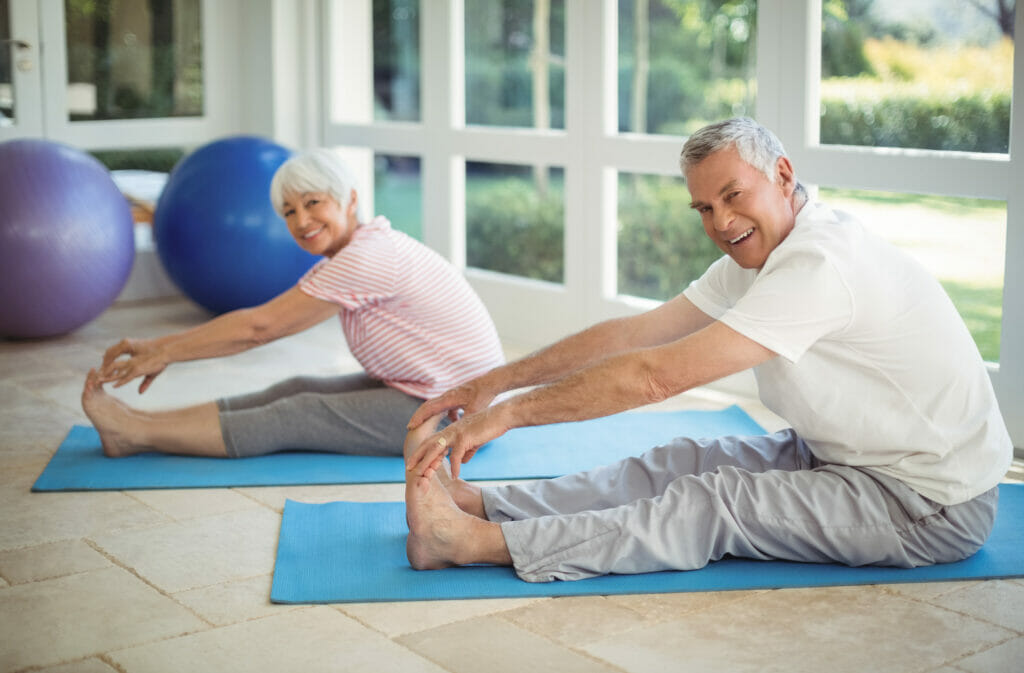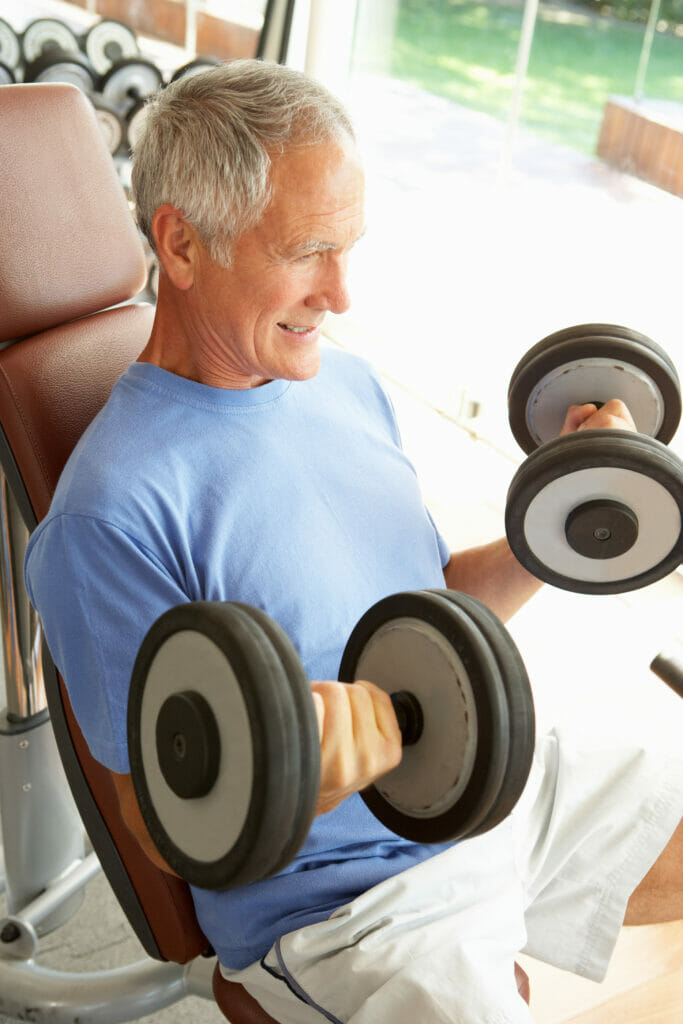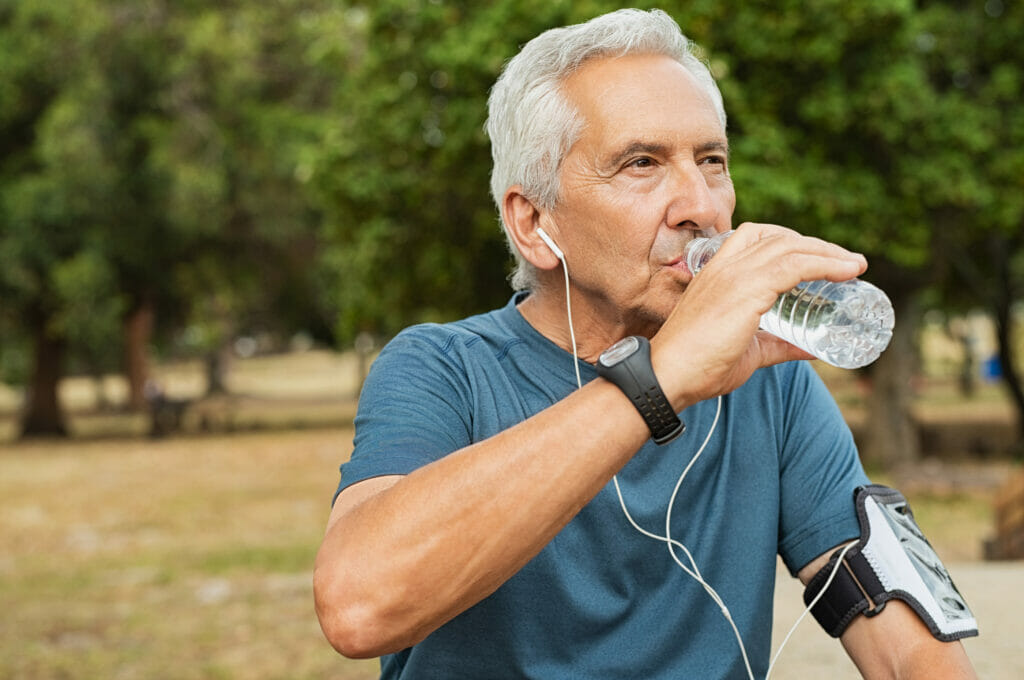
As a home health physical therapist, I hear folks blame a lot of stuff on “just getting old” all the time.
Achy joints… just part of getting old.
Having a hard time getting out of the recliner… just getting old.
Getting short of breath trying to walk to the kitchen… you guessed it, just part of getting older.
Well, the reality is a lot of things do legitimately happen as we age, which can affect our strength, mobility, and endurance, but losing the ability to care for ourselves isn’t a natural part of aging.
There are things we can do to help prevent the loss of strength, mobility, and endurance as we get older.
And yes, I’m talking about exercise.
I assure you, regardless of your age or physical condition, there are exercises you can do to help improve your condition (or at least help maintain what you’ve got).
In this article, I’l go over some general tips we can all implement to help us stay strong and mobile as we get older.
If you’re dealing with serious health issues that affect your mobility or ability to exercise, it’s always a good idea to consult your physician or local physical therapist before starting a new exercise routine.
5 Tips To Stay Fit As We Age

1. Anyone Can Get Stronger
This is something I find myself telling my patients all the time and I’m pretty sure most of them don’t believe me- but it’s true.
No matter how old you are, you can get stronger.
It’s true that losing muscle mass and overall strength is a natural part of aging (known as sarcopenia), but exercise can help slow it down.
As we age, chemical imbalances tend to occur in our muscles, causing them to break down faster than they are repaired, which over time leads to faster muscle loss.
And immobility can increase the affect of these natural occurring changes.
In other words, if you don’t use it, you lose it.
Luckily, using our muscles on a regular basis can help prevent or at least slow down this muscle loss.
Resistance training is the best way to improve muscle strength and you don’t need a lot of fancy gym equipment to get the job done.
A home gym machine is certainly a nice option for the folks who have the space and budget for one, but a nice set of resistance bands can get the job done too.
Even bodyweight exercises can be quite helpful.
I have almost all of my patients perform sit-stand transfers from a chair as part of their strengthening program because it’s a safe way of doing squats (which target pretty much every muscle from the waist down).
I alter the exercise, depending on each patient’s status, by adjusting how high the seat is and how many arms they use to push off during the transfer.
Leg raises (lying down or standing), toe raises, mini-squats are all good bodyweight exercises for the lower extremities.
For the arms, there’s always pushups (with various alterations as needed), chair dips, shoulder flys of various varieties.
Overall, I think we should all be doing some type of resistance training, especially as we get older, because it can significantly help reduce muscle loss.
And the stronger we are, the easier everything gets – getting up from chairs, going up/down stairs, walking, lifting groceries, etc.
2. Everyone Should Stretch
I admit I need to take my own advice on this one because stretching isn’t something I do on a very regular basis.
I stretch when I’m sore or having a pain somewhere, but it isn’t exactly a part of my regular routine.
But it should be because stretching can help prevent pain and help maintain mobility.
As we get older, a lot of us have to deal with achy joints, arthritis, or other types of degenerative joint disorders that can limit our mobility.
And as it gets harder or more uncomfortable to move, we start moving less.
Which makes our joints and muscles even tighter, making it even harder to move, and so on.
I’m sure you can see how easy it is to get stuck in this vicious cycle.
Well, stretching is something that can help.
It might not be able to reverse any joint damage that’s already there, but stretching can often help improve muscle flexibility and discomfort related to some of these joint disorders.
Stretching can also help keep our joints moving gently, which may help prevent further loss of mobility.
The types of stretches you can do depend greatly on your pain level and mobility status, but generally speaking, here are some of the key areas we should be focusing on as we get older:
- Hamstrings (can help with hip, knee, and back pain)
- Hip flexors (can help with back/hip pain)
- Hip adductors (can help with hip/knee pain)
- Post hip (glutes/piriformis, very helpful for hip/low back pain, Sciatica)
- Low back
- Pecs (helpful for posture, neck pain)
- Posterior delts (good for shoulder pain)
Again, there are a ton of different ways to stretch these muscle groups, so most folks can find comfortable ways to perform these different stretches.
You can find a lot of videos and images by searching online for these individual stretches (feel free to reach out to me directly as well for more info).
3. Walk, Walk, And Then Walk Some More
This is one of the most important tips I find myself telling my patients and it’s true for all of us – walking is great exercise!
Yes, walking counts as exercise and not only can it help improve all kinds of things like cardiovascular function, circulation, and endurance, but it can also help you maintain your leg strength.
And we already talked about how being stronger is always a good thing.
Walking is also great because a lot of us can do it fairly comfortably and you don’t have to have any equipment to do it – you can walk anywhere.
You can walk laps inside your home if you’re not able to walk outside; and walking outside is always great if you’re able to do so safely.
If you have a smart watch or pedometer, you can use your daily steps as a way to track your progress.
If not, you can always time yourself.
When I’m starting a walking program for a patient, I’ll usually have them walk in their home until they feel like they need to sit and rest.
I time them as they walk to see how long they can walk comfortably.
And this time becomes their baseline.
Every day I ask them to walk at least this long and to gradually increase that time as they feel able.
With the ultimate goal of getting 20 – 30 min/day.
Also keep in mind, you can split these walks up throughout the day – you don’t have to do it all at once.
20 – 30 minutes of walking might sound intimidating at first, but maybe you can do 3, 10 minute walks each day…
It’s all about doing what you can safely and comfortably and working from there.
Regardless of how you do it, walking is a great way to maintain and improve strength, endurance, and overall health.

4. Pain Isn’t Normal
I realize pretty much all of us will have some pains here or there as we age, but that doesn’t mean pain is a normal part of getting older.
Pain is your body’s way of telling you something isn’t right.
Degenerative disorders, like arthritis, are really common and yes, most of us will have some degree of arthritis in our lifetime, but that doesn’t mean we should accept pain as a normal part of getting older.
Arthritis can cause pain, but it doesn’t always – often other issues may be the real cause of your pain.
As a therapist, I’ve seen a lot of patients that were told they had arthritis and that’s why they were having pain.
As a therapist, I can’t reverse the joint damage that’s already been done, but I can often help improve muscle imbalances, tight muscles, alignment issues, posture, and stuff like that.
And many times, working on this other stuff helps alleviate the pain.
To me, this shows that other stuff may be really causing the pain, but the arthritis gets blamed for it because that’s what shows up on the x-rays.
That said, of course the arthritis itself can be the root cause of pain, I know this is true.
People with severe joint degeneration are only going to get better with a joint replacement.
Anyway, I think my point here is that you shouldn’t just accept that pain is a part of getting older. If you’re having pain that’s affecting your ability to exercise or care for yourself, please get it checked out.
Oh, also – the whole “no pain, no gain” thing isn’t true!
99% of the time, if you’re having pain with exercise, you need to switch something up.
Again, pain with exercise is usually your body saying that something isn’t right and if you try to push through it, you’re likely going to make it worse.
The key is finding comfortable, relatively pain free ways of exercising as we get older.
5. Our Balance Can Improve
Balance, like strength, is something that most of us can improve on as we get older.
Now if you have an underlying neurological condition, you may be limited on the benefits you can get from balance exercises, but healthy individuals can always benefit from balance training.
And improving our balance is a great idea as we get older because it can make us safer with walking and all the daily activities we have to complete to stay independent.
Something I tell my patients though, is that it tends to take a bit longer to feel the results from balance training, when compared to say, strength training.
It can take months to start noticing improved balance, but trust me, it’s worth it.
The tough part about implementing effective balance exercises is that we need to be doing activities that legitimately challenge our balance.
And these can be unsafe to do for folks with balance deficits.
You may need a spotter to make sure you don’t lose your balance completely and fall.
If your balance is fairly good to begin with, you may be ok to do them by the kitchen counter where you can grab on if necessary or in a corner where you have walls around you.
Just remember safety is always the priority.
There are a lot of different static and dynamic balance exercises you can do at home and where you start all depends on your skill level.
Here are a few examples of balance exercise you can try at home though:
- Static stance with feet side by side x 60 sec
- Performing head nods/rotations while standing feet side by side – sets of 10
- Standing with eyes closed x 30 sec
- Front/side/backward stepping (think of a lunge without the knee bend) – sets of 10
- Alternating toe taps on a stair without holding on – sets of 10
- Marching in place without holding on – sets of 10
- Single limb stance x 30 sec
- Stepping over an obstacle (broom on floor) – sets of 10
You could pick 3 of the above exercises, depending on your abilities, and perform them daily to help improve/maintain your balance.
Again, be safe – use a spotter when in doubt.
Final Thoughts
When I started The Home Gym, I promised myself I wasn’t going to turn it into a therapy blog because I wanted to do something a little different than what I was dealing with with my day job.
And for the most part, I feel like I’ve kept that promise.
But every once and awhile, I do sneak a little therapy article in here or there, mostly when I feel it’s important stuff we should all know.
Anyway, I thought this was an important topic and definitely worth talking about here.
As we age, there are natural things that happen – and most of ’em kinda suck.
We lose muscle mass, we get stiffer, our joints and muscles lose flexibility, we get tired easier, and it even takes longer for us to recover from injuries.
In other words, getting old isn’t for wimps.
But exercise is the best weapon we have to combat all this stuff.
Exercising on a regular basis can help us maintain our strength, flexibility, and endurance as we age and ultimately help keep us independent for as long as possible.
Just keep in mind we have to be as safe as possible when exercising.
When in doubt, please reach out to your physician or physical therapist for exercise ideas. You can also leave comments here and I’ll get back to ya as soon as possible.


